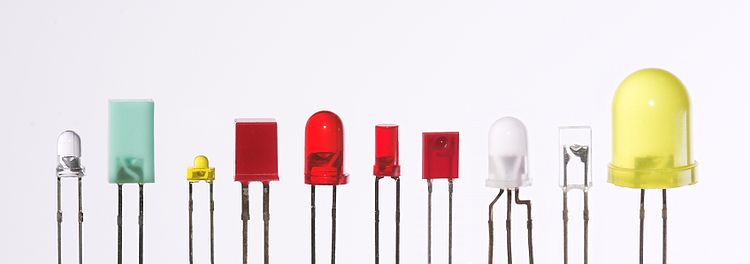About LED's
What is LED?
Light emitting diodes, commonly called LEDs, are real unsung heroes in the electronics world. They do dozens of different jobs and are found in all kinds of devices. Among other things, they form the numbers on digital clocks, transmit information from remote controls, light up watches and tell you when your appliances are turned on. Collected together, they can form images on a jumbo television screen or illuminate a traffic light.
Basically, LEDs are just tiny light bulbs that fit easily into an electrical circuit. But unlike ordinary incandescent bulbs, they don’t have a filament that will burn out, and they don’t get especially hot.
They are illuminated solely by the movement of electrons in a semiconductor material, and they last just as long as a standard transistor. In this article, we’ll examine the simple principles behind these ubiquitous blinkers, illuminating some cool principles of electricity and light in the process.

Why LED's
- Long Life
- Energy Efficiency
- Ecologically Friendly
- Durable Quality
- Zero UV Emissions
- Design Flexibility
- Operational in Extremely Cold or Hot Temperatures
- Light Dispersement
- Instant Lighting & Frequent Switching
- Low- Voltage
LED Lights Vs CFLs
1. Low Temperatures:
LEDs produce almost no heat, converting most of the electricity into light. CFLs, while producing less heat than a normal incandescent bulb, still emit a large amount of heat. LEDs therefore reduce the risk of fire and accidental burns on contact.
2. Mercury:
CFLs contain mercury – they have to otherwise they wouldn’t work. This might be great for producing light, but it does no favours for the environment. If a CFL is not disposed of correctly, the mercury can be released in vapour form endangering any person or animal who inhales it. LEDs do not contain mercury, and as such are far better for the environment.
3. Colour:
Most CFLs come with limited colour profiles. They are normally blue/white, or tinged with yellow. This light can appear stark, and is why most people have to use a variety of lampshades in order to diffuse the light slightly to improve appearance. LEDs can be bought in many different colours which is one of the reasons they can be used in so many different situations.
4. Energy:
LEDs use far less energy than CFLs. This might surprise people as CFLs are often marketed as “energy saving bulbs”. While this is true, when compared to LEDs there really is only one winner. LEDs will reduce electricity bills substantially while providing all of the light you need.
5. Mains:
Most CFLs need to be hooked up to a mains supply in order to work. LEDs on the other hand do not require this. They can be powered with something as small as a watch battery. This makes them perfect for decorative or temporary use, and when used outside it circumvents any worries about having a mains supply outdoors, even when weather-proofed.
6. Variable:
LEDs can be bought in variable forms which means that one bulb can in fact be set to a number of different colours, or to alternate through several colour profiles over a set period. Perfect for Christmas decorations!
7. Size:
While CFLs have been coiled to save on space, they cannot hold a candle to the space busting size of an LED light. Most LEDs are very, very small, and are therefore perfect when used as downlights, as they do not protrude from a ceiling in the same way as CFLs do.
8. Longevity:
CFLs can last for an impressive 10,000 hours, but LEDs dwarf this number, working for as long as 60,000 hours! This cuts down markedly on spending time and money replacing them.
9. Dimmers:
LEDs are more pleasing to the eye when used in conjunction with a dimmer switch. CFLs are stark and cold, but LEDs can be set to a variety of light levels mimicking the warm glow of a candle or the bright light of a halogen bulb.
10. No Glass:
LEDs often contain little or no glass. This means they are far more durable, can take a knock or two, and will not leave tiny pieces of glass on surfaces for children or animals to stand on, should one be broken.
